7 social media trends you need to know in 2026

Table of Contents
Combining social media performance and consumer data paints a vivid picture of the future of social media trends—one that’s so bright we need sunglasses. Data shows you what’s driving audience behavior and where your brand fits in the mix.
That’s why we’ve compiled some of our most relevant data points from our most recent reports—including The 2025 Impact of Social Media Report—to help you build a strategy that drives real business results. We also spoke to top social media marketing experts to get their practical advice for social marketers.
Read on to discover the latest social media trends you need to know in 2026.
Download the 2025 Impact of Social Media Report
Trend 1: Video is (still) king
Of course, video is the first social media trend on our list. TikTok, Instagram Reels, YouTube Shorts and other emerging video formats on LinkedIn and Threads have created feature parity, making video content a priority across networks.
We already know short-form video is one of the best ways to connect with your audience and reach new followers. But long-form video still has its place across platforms. Instagram Reels range from 15 to 90 seconds. TikTok videos are three seconds to 10 minutes long. And as of October 2024, YouTube Shorts can now be up to three minutes long.
This update was a smart move from YouTube for a couple of key reasons. Per The 2025 Sprout Social Index™, YouTube is one of the top three platforms where people have social media profiles.
YouTube is also attracting the attention of marketing leaders, 68% of whom say it drives the most business impact, according to The 2025 Impact of Social Media Report.

And experts say that YouTube’s influence in the social video space is only going to grow in 2026 and beyond.
“Social-first video will remain central, but audiences are fracturing across platforms,” says Tameka Bazile, Creator and Assoc. Dir. B2B Social and Content at Business Insider. “YouTube is especially well-positioned to win on both sides: it’s capturing streaming eyeballs in the living room and still holding strong influence in creator culture. That dual power is only going to grow.”
A great example of video-first social marketing is GoPro. The tech company leans heavily on video content to promote its gear across platforms like Instagram, TikTok and YouTube. While it often repurposes content, it also creates video specifically tailored to each platform. Not to mention, GoPro frequently partners with creators of all niches and sizes, broadening their reach.
On Instagram, the brand often posts short-form Reels in collaboration with adventure content creators or extreme athletes. These videos typically showcase the activities GoPros are designed to capture, whether it’s shark diving, downhill skiing or mountain biking. For instance, one of its collaborations captured creator Chris Finck’s POV as he BASE jumped from a bridge.
GoPro’s YouTube content is usually longer, in line with users’ interests and habits on the platform. However, it still teams up with creators in interesting and unexpected ways, cutting through the noise and grabbing users’ attention.
In June 2025, GoPro partnered with influencer Susi Vidal, known for her “Only Pans” series that takes a playful, bawdy approach to home cooking. With nearly 4 million followers on TikTok and 433K on YouTube, Vidal has gained the trust of a sizeable audience. GoPro tapped into that by featuring her in a cooking video posted to its channel, filmed entirely on a GoPro HERO13 Black.
A diversion from its typical adventurous content, this laid-back video concept was also the perfect way to showcase GoPro’s diversity.
Brand takeaway
While repurposing content can be effective, brands need to look beyond a one-size-fits-all approach. Create unique content that aligns with users’ behaviors and preferences on each platform—think bite-sized Reels on Instagram and TikTok and long-form storytelling pieces on YouTube.
Don’t be afraid to collaborate with creators outside your niche, focusing on topics your audience cares about, to highlight your brand’s versatility. Whether it’s a BASE jump or a home cooking demo, each video has the power to connect you with new audiences and deepen engagement.
Trend 2: AI-generated content will become mainstream
In the year ahead, AI’s influence on social media marketing will continue to grow. Marketing leaders are buying into its importance more than ever, with 97% saying that marketers must know how to use AI, according to The 2025 Index.
More specifically, AI-generated content will become increasingly common. Thanks to these innovations, marketers won’t need advanced skills to bring posts to life. Instead, they can focus on ideation and quality assurance, while AI handles the basics.
“AI allows the average person to simply imagine content and publish. Without the need for equipment, editing skills or people, content will only require a great concept or idea to become a reality,” explains Jim Lin, Director of Enterprise Social Media at Caterpillar.
Heinz started experimenting with AI-generated content in 2022 when it launched its AI ketchup campaign. The premise was simple: the company asked multiple AI tools what it thought ketchup looked like. While the results varied, each bottle had one thing in common: they bore a striking resemblance to Heinz bottles. The takeaway became that, like humans, bots prefer Heinz ketchup.
Unexpected and topical, this campaign was ahead of its time. But moving into 2026, marketing tactics like this will become the new normal.
With that said, as AI-generated content proliferates, brands need to be even more conscious of social media marketing ethics. Specifically, they must ensure their AI use aligns with consumer rights and values.
For example, Sprout’s Q3 2025 Pulse Survey found that more than half (52%) of social users are concerned about brands posting AI-generated social content without disclosing it.
In contrast, 65% of respondents in Sprout’s Q4 2025 Pulse Survey said they would be comfortable with companies using AI to deliver faster customer service on social.
Brand takeaway
In the age of AI-generated content, a key differentiator for your brand will be how human it feels. Use AI as a creative sparring partner, but leave the creative direction to the humans. All content you share should have a human touch of storytelling and authenticity—these form the foundation for meaningful relationships with social users.
As Kara Redman, CEO of Backroom, a brand strategy and activation agency, puts it: “As AI content goes up, our desire for content that feels human will become more in demand. Relatability will be key, so less polish and more real-world.”
Transparency is also a non-negotiable to build trust with your audience. If you’re going to use AI-produced content, be forthcoming about it.
Trend 3: Serialized content will earn audiences’ attention
In the Sprout Social Q2 2025 Pulse Survey, we asked people what they most want to see from brands on social. Two responses came neck and neck: interacting with audiences (58%) and posting original content series (57%).

But what is it about serialized content that consumers enjoy so much?
Oftentimes, content series enable brands to delve deeper into topics that matter to them and their audience, laying the groundwork for more meaningful connections. Plus, series often feature a recurring cast of characters. As viewers continue to tune in, they get to know these characters—and that keeps them coming back, our 2025 Content Benchmarks Report found.
According to Angelo Castillo, the creator behind ProfitPlug, that’s because “people follow people, not brands. The hype around just a brand name is fading. Audiences want personality and consistency from faces they recognize.”
With that in mind, Castillo says some series work better than others.
“Two extremes are doing well: raw, unedited yap videos and highly cinematic production-heavy content,” he explains. “A lot of brands and startups are creating series that mirror TV shows, like Office-style workplace content. The common thread is serialization; people want to follow along and come back for the next episode.”
Taking a page from “The Office” is what Shameless Media did to create serialized content. While the Australian media business usually shares clips from its various podcasts on its accounts, it also launched an Office-style series entitled “The Shoffice”.
The series features raw footage of the Shameless women at work, giving an unprecedented peek into the brand’s fun, fresh workplace culture. Equal parts cheeky and unfiltered, “The Shoffice” resonates with the brand’s Millennial and Gen Z audiences, who crave authentic, behind-the-scenes access.
Shameless even built on the momentum by giving it its own spinoff series, “Out of Shoffice”, which captures the staff’s out-of-office adventures with the same playful charm.
Brand takeaway
When crafting episodic content, prioritize your people. While the style of content is important—be it lo-fi vlogs, direct-to-camera interviews or polished short-form documentaries—it’s the people who will keep audiences coming back. Whether it’s your in-house team or external creators you continuously collaborate with, consumers want to see familiar faces, interesting dynamics and evolving stories. In other words, content that feels like a binge-worthy show.
Trend 4: Brands will prioritize resonance and community over virality
According to The 2025 Content Benchmarks Report, brands published an average of 9.5 posts per day across networks in 2024. Although this is a slight dip from 2023, many consumer-facing industries—like media, retail, leisure, sports and recreation—surpassed this threshold, sometimes quadrupling that figure.
As a result, we’re still seeing extreme levels of social media saturation. Content cycles are moving faster than ever, with social media trends often little more than fleeting moments. Social users can barely keep up, let alone engage.
To be successful in 2026, experts say brands must strategize to overcome social media fatigue. A key part of that strategy is posting less frequently and more purposefully.
“Saturation is a signal. But not one to get louder, but to get more intentional,” says Greg Swan, Senior Partner at FINN Partners agency. “If your brand disappeared from social tomorrow, would anyone notice? If not, it’s time to start creating moments that matter.”
The moments in question? Those that make people feel seen and heard.
“Treat your audience like a community, not just customers. Even if you’re a B2B brand or a utility company, there’s an opportunity to build loyalty and identity around what you stand for. Give people inside jokes. Let them feel like insiders. Make them proud to be part of your story,” Swan adds.
A great example is the recent “Group 7” TikTok posted by indie musician, Sophia James. James posted seven videos to her account to see which would get the most engagement. For each, she assigned viewers to a group number corresponding to the video number (i.e. viewers who saw the seventh video on their For You page were in “Group 7”).
With the seventh video, James hacked the algorithm, gaining over 84 million views, 9 million likes and 500K comments at the time of publication.
It even attracted the attention of some high-profile brands and influencers, including Fenty Beauty, which commented, “group 7 the baddest we don’t make the rules”. Not to mention, thousands of creators made their own videos, proudly declaring their “Group 7” status.
Although the video was unpolished and unproduced, it tapped into something incredibly powerful: the human desire to belong. And that sense of belonging is what turned a simple moment into a social movement.
Brand takeaway
In 2026, connection will be the currency that matters most on social. A desire to feel like a part of something bigger than themselves will drive users toward brands that prioritize resonance over reach. Instead of chasing virality, focus on building community with your audience by sharing content that features inside jokes, shared identities or interactive storytelling.
Trend 5: Content and network strategies will center on audience engagement
In 2026, listening to your audience won’t be enough. To maintain a competitive edge, you’ll need to anticipate their needs and wants.
Fortunately, there’s ample data available to point you in the right direction. For example, Sprout’s Q4 2025 Pulse Survey uncovered that interacting with audiences in smaller spaces (e.g. broadcast channels) and surprise-and-delight moments are the top things Gen Z wants brands to prioritize on social in 2026.
Plus, The 2025 Index revealed that two of the top traits that make brands stand out on social are how they engage with their followers and how quickly they respond to customers.
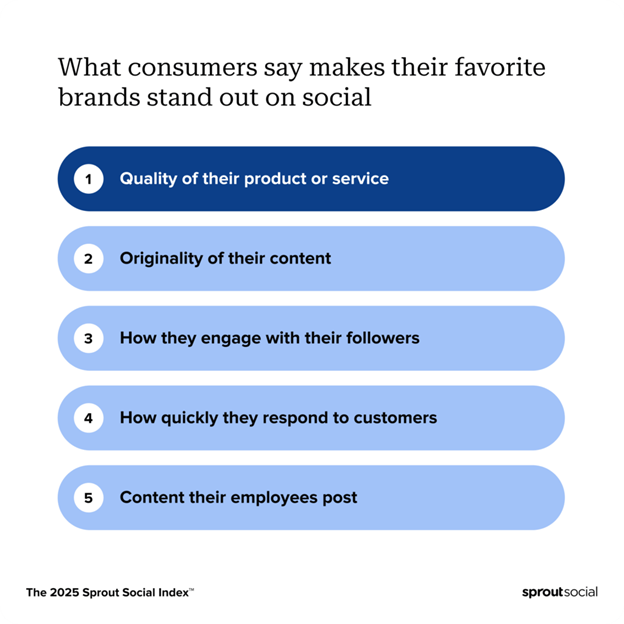
Responding quickly is a must; roughly three-quarters of social users agree a brand should reply on social within 24 hours. Most users said if a brand doesn’t respond at all, they’ll buy from a competitor.
In turn, experts believe community management will be a key social media marketing trend in 2026.
“Community management is finally getting its moment again,” says Kendall Dickieson, Freelance Social Media Consultant and writer of No Filter. “As brands realize that organic reach depends as much on how they engage as what they post, we’re seeing community teams move from reactive to proactive, whether it is sparking conversations, nurturing superfans, and building micro-communities across platforms.”
She adds, “budgets are starting to follow. More brands are carving out dedicated resources for community, whether that means hiring specialized managers, investing in social listening tools, or building programs that reward their most engaged followers.”
Emerging platforms like Substack and Bluesky are expected to play a big role in this shift, too, as they empower brands to connect directly with their audiences.
“Interest in Substack will explode in 2026,” shares Lia Haberman, creator economy expert and author of the ICYMI newsletter. “The appeal is obvious: direct audience access, more intentional engagement with the content than the average social post and the opportunity to be part of the cultural zeitgeist. It’s giving 2020s TikTok energy, and no one wants to miss the rocketship.”
Brand takeaway
To thrive on social, brands can’t just react—they need to pay attention to their audiences and plan ahead.
As Dickieson mentioned, social media intelligence and listening tools will be crucial here. Use them to proactively monitor audience sentiment, identify emerging needs and capitalize on the moments that matter most.
By marrying social listening with responsiveness, you’ll build a stronger, more loyal brand community.
Trend 6: Authenticity and human-led storytelling win over hearts and minds
Moving into 2026, brands need to prioritize genuine connection and storytelling, rather than blindly hopping on social media trends and chasing fleeting moments.
“The brands getting genuine engagement aren’t the ones with the fastest turnaround on trending audio,” explains Haberman. “They’re the ones building recognizable characters, lore, and brand worlds that feel distinctly theirs. Trends can be a tool, but they can’t be your entire strategy.”
To satisfy that craving for real connection, brands must again be cautious with their use of AI, specifically virtual influencers. While some believe that AI-powered creators are the future of influencer marketing, consumers feel differently. Per the Q3 2025 Pulse Survey, 46% of social media users are not comfortable with brands using AI influencers.
Bazile echoes this sentiment, urging brands to “do away with AI ‘artists’, ‘creators’, or even the use of AI for ads. Audiences can feel when something wasn’t made by a real person. They crave human tone, real experience, and the imperfections that make content relatable. But the more brands lean into AI-made content, the more they normalize this kind of inauthenticity.”
Instead, partner with human creators who are topically aligned to your brand to tell richer stories and provide audiences with a familiar (and real) face they’ll remember.
Take Square as an example. On its social accounts, particularly YouTube, Square spotlights real businesses that use its payment technology in its “See you in the neighborhood” series. The videos feature entrepreneurs discussing the relationships between their local communities and their businesses.
Featuring real voices and community-driven narratives, it’s a case study of how people-led storytelling can foster relatability and trust.
Brand takeaway
As the social landscape grows more saturated with AI content and short-lived social media trends, users will cling to what’s tangible: emotional resonance.
For brands to overcome social media saturation in 2026, Jordan Tennenbaum, Head of Social at Talkdesk, said brands need to “be creative, be fun, focus on people, and avoid sharing boring, cookie-cutter, robotic marketing content.”
The most impactful brand strategies will be those that feel human and grounded amid the social media noise. Brands should focus on rich storytelling, character-building and creator collaborations that reflect real experience; that way, users see themselves in the content and connect deeply with it.
Trend 7: Social search remains a priority
Social media search is now outpacing traditional SEO for younger generations, according to Sprout’s Q2 2025 Pulse Survey. It revealed that nearly one in three consumers skip Google altogether, instead starting their search journey on networks like TikTok, Instagram or YouTube. This number rises to more than half for Gen Z. And consumers aren’t just searching for entertainment; they’re looking for content to inform their purchases, such as how-tos, product demos and reviews.
Plus, as more networks introduce AI-driven search features, discovery is continuing to evolve. Similar to Google’s AI Overview, AI social search results provide content summaries to give direct, scannable answers to user queries, such as the one from Meta AI seen below.
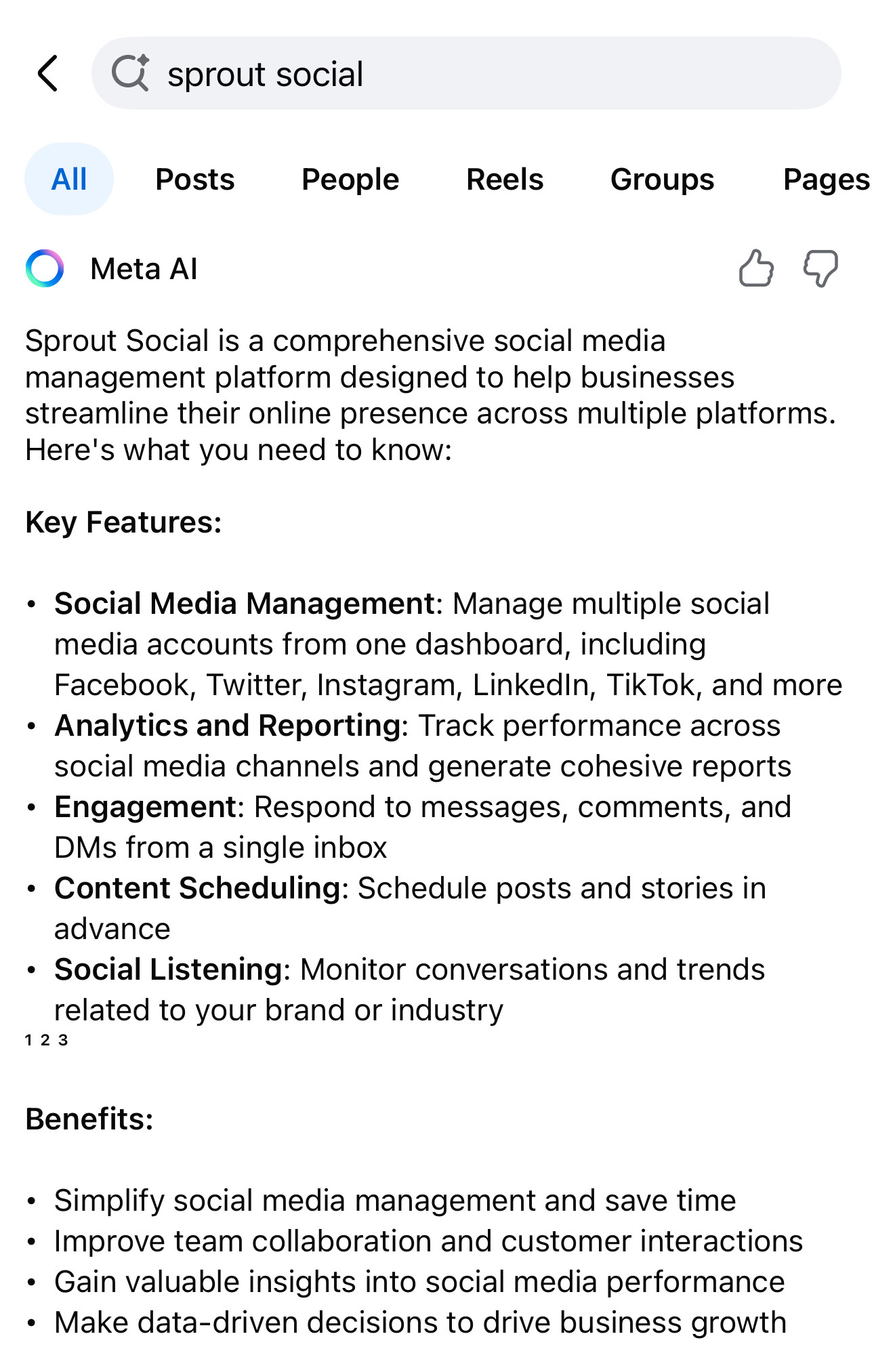
Brand takeaway
The next generation of marketers is using social engine optimization and learning how to master answer engine optimization (AEO). Consider how you can optimize your content for social search across networks and pay attention to emerging AEO tactics so you can incorporate them into your own strategy where appropriate.
Additionally, pay attention to the evolving impact of social on traditional search. For example, Reddit, YouTube and Instagram posts showing up in search engine results pages (SERPs). And social content often satisfies search engines’ E-E-A-T criteria through high levels of virality and engagement. These metrics all signal authority, helping boost brand visibility.
Learn more about social media trends in 2026
There are so many social media marketing trends ahead going into 2026. This list just scratches the surface of what your brand should know. Read The 2025 Impact of Social Media Report for more.

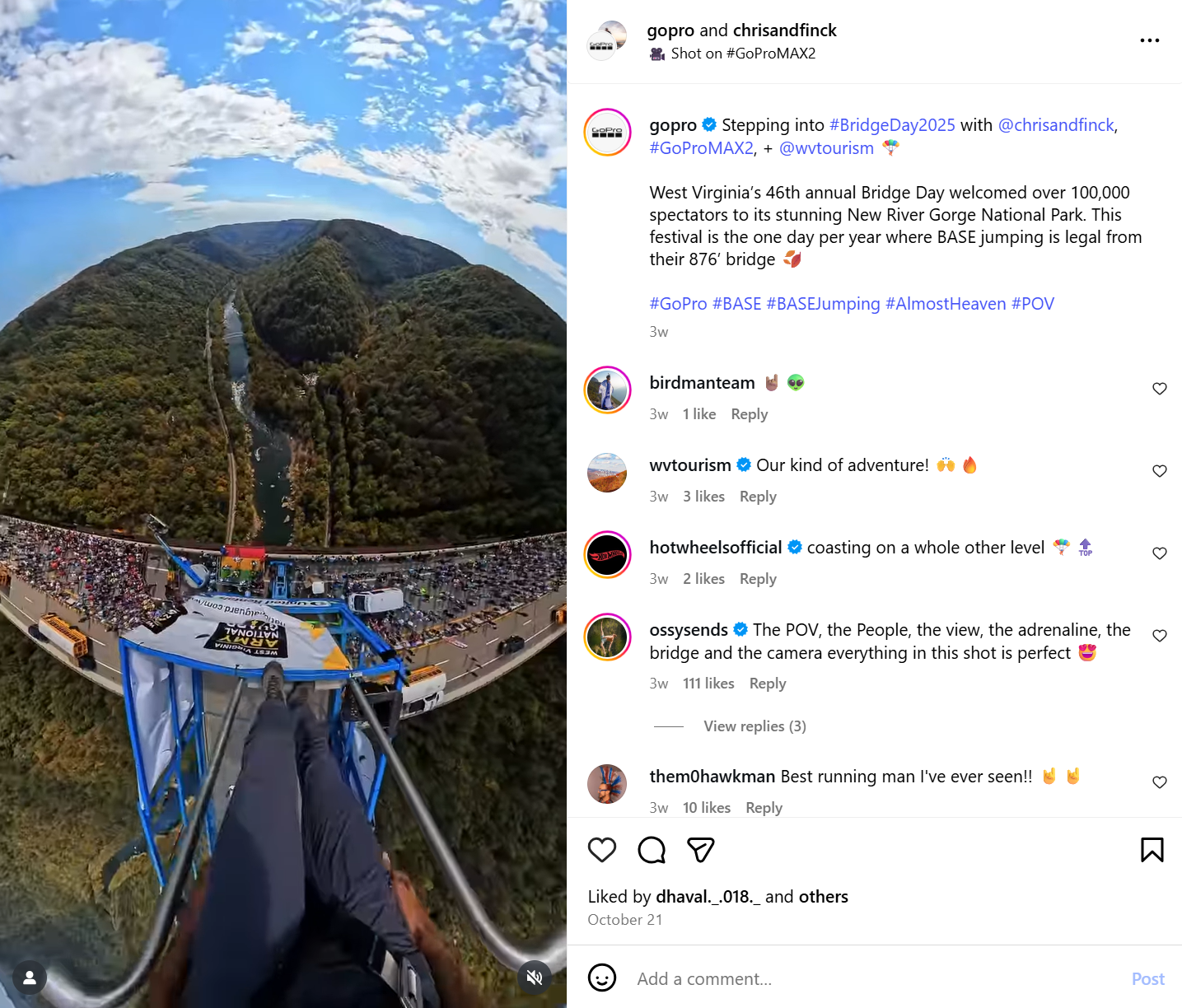

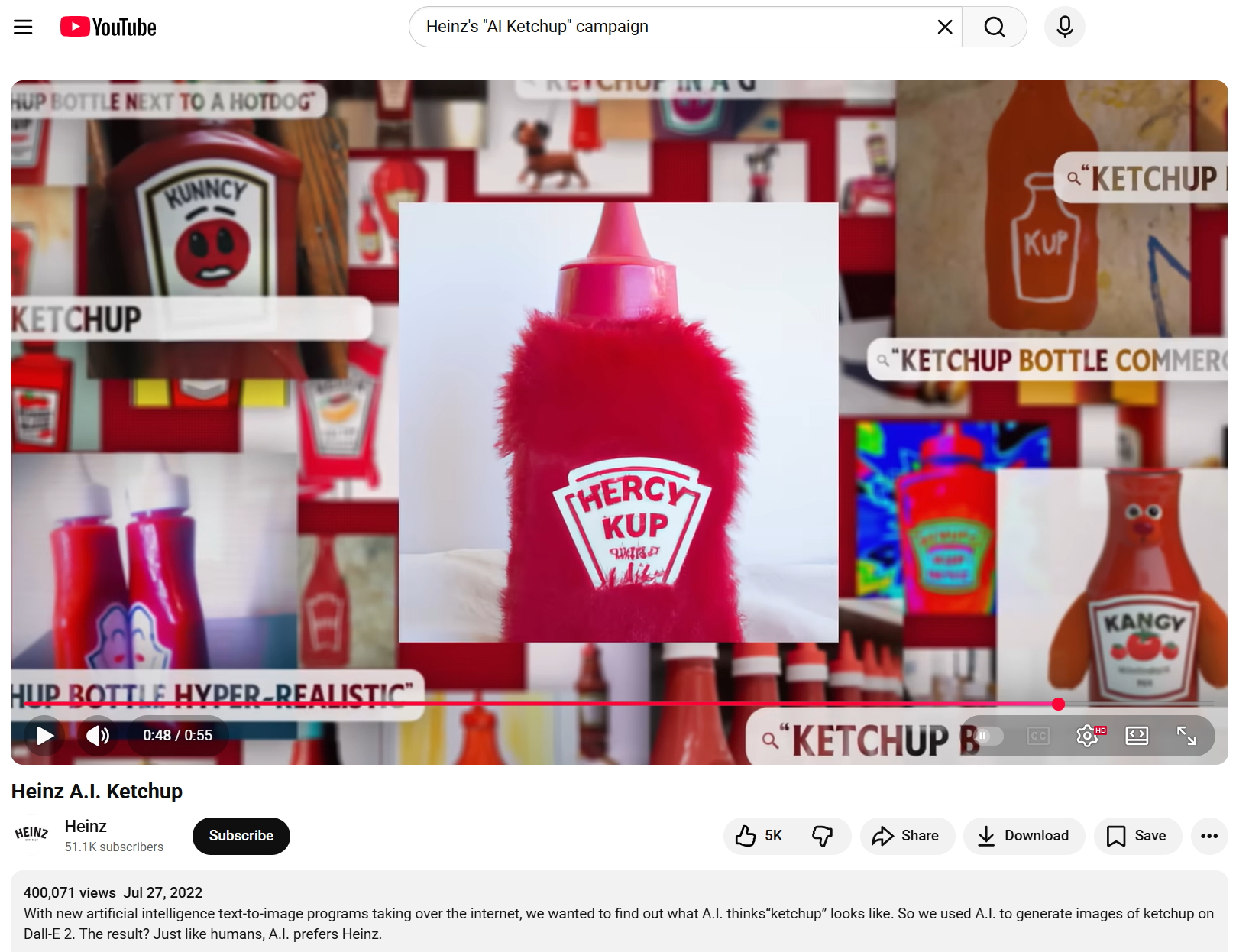


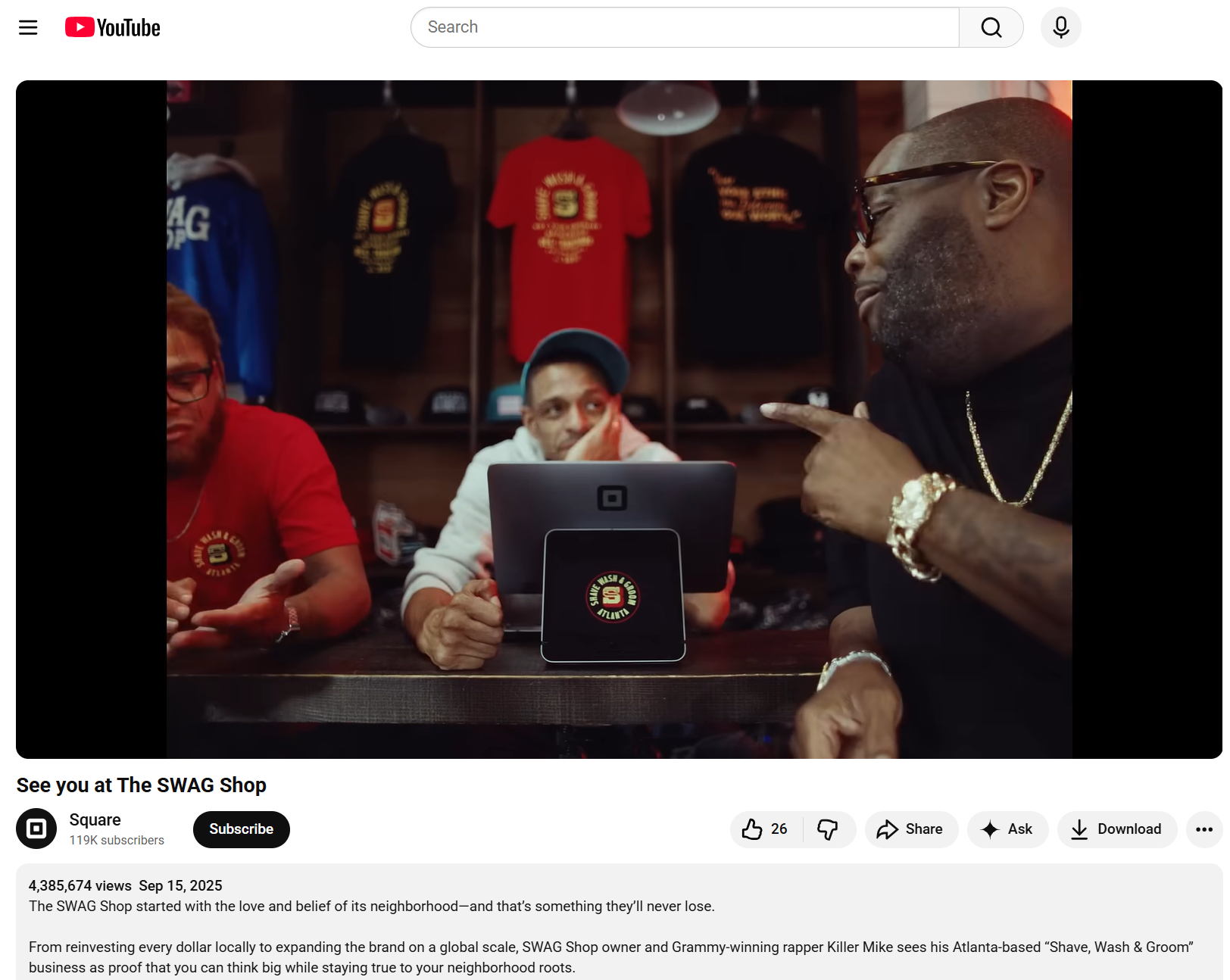


Share